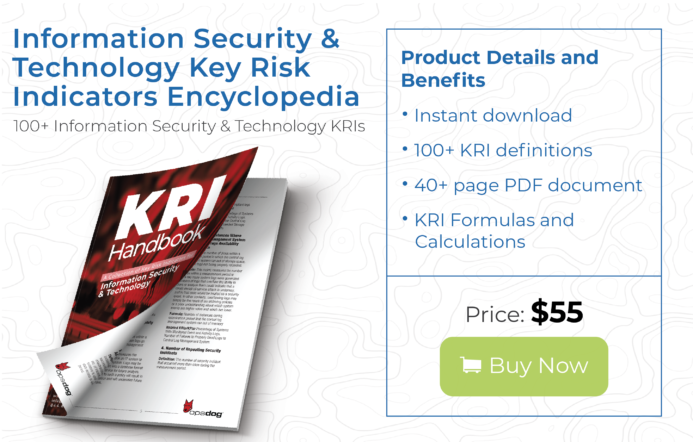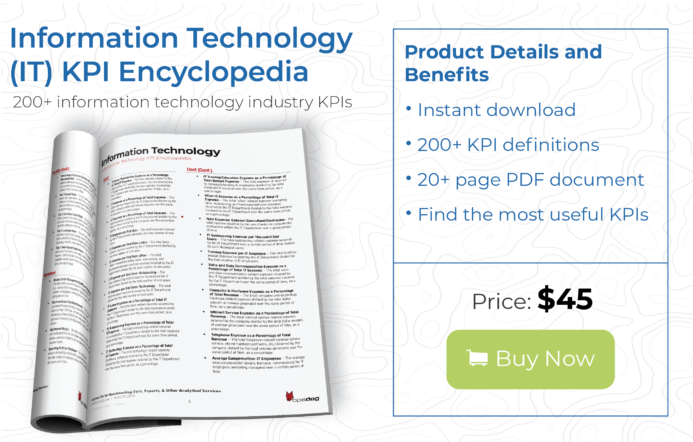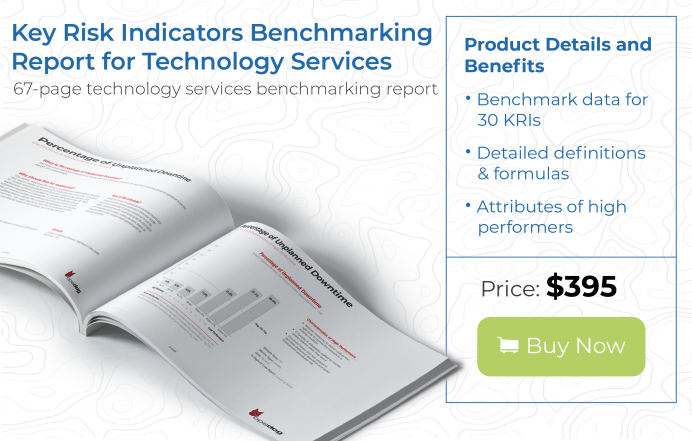The IT project management team’s job is to ensure that all technology-related projects run according to plan, align with the company’s overall business strategy, reduce risk of failure, and finish on time. It should go without saying then, that measuring IT project management effectiveness through Key Performance Indicators (KPIs) is an important part of keeping your technology project management operations running smoothly.
What are IT Project Management KPIs?
IT Key Performance Indicators relating to project management can be defined as quantitative measurements, or metrics, used to determine how specific IT project management operations are accomplishing a company’s Information Technology (IT) project goals over a set period of time.
Benefits of measuring and benchmarking project management-related IT metrics and KPIs in your company’s operational measurement initiatives include:
- Improved IT employee productivity and performance management
- Reduced instances of bugs found by end-users
- Reduced operational costs for IT projects
- Improved IT project planning and forecast practices
Let’s take a moment to read up on 5 Key Performance Indicator examples for Information Technology project management that your IT project manager should measure when managing any kind of IT analysis or implementation.
IT Project Management Key Performance Indicator # 1: Percentage of IT Projects Finished on Time
IT projects are notorious for going over budget and taking longer than planned to fully implement. But this can be improved if you utilize the proper IT Key Performance Indicators. Use the Percentage of IT Projects Finished on Time KPI for the IT Department to measure the percentage of IT-related projects undertaken during a defined period of time that were completed within the agreed upon timeframe.
While you hope your value for this IT Key Performance Indicator is high, IT projects can quickly get out of hand and take more time and resources than initially planned. Low values for this IT KPI example can be indicative of:
- Poor IT employee productivity and performance management practices
- Inadequate project management task planning and forecasting practices
- Inefficient communication between stakeholders, IT project managers and IT employees
This Key Performance Indicator example for Information Technology assumes that all IT projects have a defined start and end date, which is not always the case. This measurement can be segmented in order to judge individual project manager, or IT employee performance as it relates to IT project management. For example, you could compare the percentage of projects taken on by two managers that were completed on time to determine which manager needs more training, or who should be promoted.
To keep the values for this KPI for IT managers high, seek to improve both communications between stakeholders and IT project managers, as well as improve IT employee performance management practices. This not only ensures that IT project managers and employees know exactly what the company’s upper-management want, which reduces the number of reiterations that have to be made due to misunderstandings, but it also allows the IT project manager to resolve any productivity issues IT employees may be experiencing. Better communication practices and IT employee productivity tracking then allow IT project managers to accurately determine just how many IT projects they can take up at any point in time without inundating themselves and their employees with work that cannot be completed in a timely fashion.
IT Project Management Key Performance Indicator # 2: Fault Slip Through Rate
Use the Fault Slip Through Rate KPI for the IT Department to measure the percentage of faults, or bugs, that make it past quality assurance teams and are reported by end users after the launch or implementation of a software application, or system. To put this in perspective, imagine launching a new application, or system, designed to make the day-to-day tasks of the company’s employees easier, and instead find that employees are flooding the IT Department with support requests because too many bugs are making the new application, or system, impossible to run.
High values for this IT KPI example can indicate:
- Poor employee work quality and performance management practices
- Inefficient software application, or system testing practices
- Inadequate implementation of bug tracking and prioritization procedures.
Let’s face it, it is typically impossible to identify every bug when testing a software, or system prior to launch. End-users have a way of bringing out the worst in your code and finding issues you thought couldn’t possibly exist. To keep values low for this Key Performance Indicator example for Information Technology, seek to first spend a reasonable amount of time testing the software application, or system for bugs prior to launch. If end-users find too many bugs once the application, or system is launched, end-user productivity can screech to a halt. If this occurs, a company’s customers can become so dissatisfied that they’d look for other companies to do business with. Having an effective system in place to track, prioritize and resolve post-launch bugs is also important as it allows IT employees to quickly resolve any bugs that are found and identify the root cause of the bug so as to prevent it from happening again. Please keep in mind that while you should aim to keep your Fault Slip Through Rate as low as possible, a number of 0 for this KPI for the IT Department is unattainable. There will always be a bug or two to fix.
IT Project Management Key Performance Indicator # 3: IT Expense per Employee
Use the IT Expense per Employee KPI for the IT Department to measure the total expense incurred by the IT Department, including hardware, software, labor and occupancy expenses, per company-wide employee. Consider this KPI for IT managers to be a must know for financial purposes. In fact, don’t just consider it, go ahead and write it down, underline it, draw a box around it and star it. This IT Key Performance Indicator provides a simple look at how much each employee costs to support from an IT perspective.
High values for this IT KPI example can be indicative of:
- Inefficient IT service operations
- Poor IT procurement cost efficiency practices
- Overstaffing within the IT Department
- Poor IT employee productivity and performance management practices
To keep the value low for this IT KPI example, keep customer, or end-user-facing FAQs, and other self-service tools up-to-date on what end-users can do to fix encountered IT issues themselves. This reduces the number of instances where the company’s employees need IT employee assistance, which provides IT employees time to focus on other important projects such as bug tracking or system upgrades. Monitor end-user use of such FAQs and use all acquired data to accurately forecast the company’s IT needs to further balance IT Department staffing and keep costs low. This can include determining if an IT outsourcing firm is needed. Be aware that while, a low value is typically seen as better, actual values should correspond with the company’s needs. Companies with a greater level of IT spending per company-wide employee, for instance, may view information technology as a strategic investment to improve the company’s overall business performance and productivity.
IT Project Management Key Performance Indicator # 4: Cycle Time: Application Development
Use the Cycle Time: Application Development KPI for the IT Department to measure the number of months required to develop an application, or software program. The first month is considered to be the time spent researching and gathering requirements, typically done through interviews with end-users and stakeholders, while the last month is considered to be when the application, or software program is launched and usable by end-users.
High values for this IT KPI example can indicate:
- Poor IT employee productivity and performance management practices
- Inadequate communications between stakeholders, IT project managers and IT employees
- Sub-par IT project documentation management
The most efficient cycle time for this KPI for IT managers may vary based on the scope and complexity of the application being developed, so it is necessary to segment data within this IT Key Performance Indicator in order to produce apples-to-apples comparisons. That said, relatively low values are still seen as better. To keep values low for this IT KPI example, ensure that stakeholders, IT project managers and IT employees gather, document and agree upon project requirements before the actual development of the application begins. This not only improves communication between all three parties, thus reducing instances of rework due to misunderstandings, but it also ensures that the number of possible requirement changes is kept to a minimum, thus reducing the overall amount of time and work spent on the project. Improving employee performance management practices also reduces the amount of time necessary to develop applications by identifying which IT employees are in need extra training.
IT Project Management Key Performance Indicator # 5: IT Project Cost Variance
Use the IT Project Cost Variance KPI for the IT Department to measure the percent difference between the budgeted and actual costs for IT-related projects. All IT project stakeholders should want this Key Performance Indicator example for Information Technology to be measured as it is invaluable in both determining overages in IT project budgets, and in pin-pointing the reasons certain IT projects are exceeding their agreed upon budget. Only once such root causes are identified, can IT project managers work to solve them and thus keep IT project overages to a minimum.
High values for this IT KPI example are indicative of:
- Poor IT employee productivity and performance management practices
- Inefficient IT project management forecasting practices
- Sub-par IT procurement cost efficiency practices
- Overstaffing of the IT Department
This Key Performance Indicator example for Information Technology can be used in conjunction with the Percentage of IT Projects Finished on Time IT KPI example to gain insight into how well your IT project management staff is planning and executing their initiatives. To keep the value of this KPI for IT managers low, ensure that only the necessary number of IT employees are staffed within the IT Department and improve IT procurement market research practices. By proactively researching the latest technologies and software available, IT managers are able to reduce the amount of time spent researching products and which vendor to use when an item purchase is needed by the company. This allows the needed item to be quickly obtained by the appropriate department and ensures that the most cost-effective product is purchased. It is important to note that while having as few IT employees as possible is preferred, the actual number of IT employees employed should depend on the needs of the company.
IT Project Management Key Performance Indicator Final Thoughts and Resources
Though many IT Departments focus only on measuring IT support KPIs, IT Key Performance Indicators focusing on IT project management is just as important. Without measuring these metrics, IT managers lose their ability to measure the operational effectiveness and cost of the IT Department itself. Poor measurements then can lead to unsustainable expenses as well as reduced productivity to the rest of the company’s employees.
Are you looking for a full list of IT KPIs? Download our IT Key Performance Indicator Catalog here.
Do you need help competitively benchmarking your IT Department against those of your peers? Help yourself to our presentation-ready IT benchmarking reports, or contact us for information concerning our Benchmarking Research and business intelligence implementation service. We’ll quickly help you benchmark your business and provide you with presentation-ready deliverables at an affordable price.


